In a perfect world there would be no conflicts, no violence, no wars. But even the small corners of the world in which each of us lives has its share of conflicts or disagreements over big and small issues. There are bound to be differences of opinions or misunderstandings that lead to arguments—teachers may want to have on-hand books that encourage talking through disagreements or spending time with someone in order to change assumptions and preconceptions. Members of the Children’s Literature and Reading Special Interest Group offer some book suggestions for titles encouraging a peaceful resolution to conflict. If all else fails, read and share a book.
Grades K-3
Beavis, Paul. (2014). Mrs. Mo’s Monster. Wellington, NZ: Gecko Press.
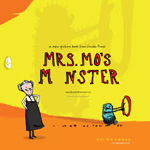 Sometimes patience, a soft word or two and redirected energy can civilize a monster. In the case of one monster bent on mayhem and in search of something to "CRUNCH, MUNCH, AND CHEW,” one determined elderly woman is all it takes to calm him down. After he barges into her house, Mrs. Mo helps the monster get in touch with his gentler side and learn about social graces. After helping prepare a cake, the monster is taken aback by the rudeness of the two little monsters who enter her house as the book comes to an end. The color-filled illustrations show the seemingly unflappable Mrs. Mo quietly yet firmly dealing with conflict by putting the monster to work. If it worked for him, it just might work for your own little monster.
Sometimes patience, a soft word or two and redirected energy can civilize a monster. In the case of one monster bent on mayhem and in search of something to "CRUNCH, MUNCH, AND CHEW,” one determined elderly woman is all it takes to calm him down. After he barges into her house, Mrs. Mo helps the monster get in touch with his gentler side and learn about social graces. After helping prepare a cake, the monster is taken aback by the rudeness of the two little monsters who enter her house as the book comes to an end. The color-filled illustrations show the seemingly unflappable Mrs. Mo quietly yet firmly dealing with conflict by putting the monster to work. If it worked for him, it just might work for your own little monster.
—Barbara A. Ward, Washington State University Pullman
Jeffers, Oliver. (2014). The Hueys In… It Wasn’t Me. New York, NY: Philomel.
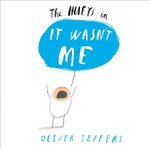 Like many of us, the Hueys somehow find themselves taking sides in an argument. As the disagreement becomes increasingly intense, it becomes clear that no one even knows how the argument started or what it is about, which provides fodder for more disagreement. Finally, Gillespie solves the problem by distracting the rest of the crew with something else far more interesting. Readers will enjoy reading and discussing this picture book and perusing the illustrations created with pencils and "a bit of orange," according to the information in the front matter. Teachers and parents will certainly recognize themselves and their own children in the Hueys' behavior. Sometimes the only way to resolve a conflict is to walk away and focus on something else.
Like many of us, the Hueys somehow find themselves taking sides in an argument. As the disagreement becomes increasingly intense, it becomes clear that no one even knows how the argument started or what it is about, which provides fodder for more disagreement. Finally, Gillespie solves the problem by distracting the rest of the crew with something else far more interesting. Readers will enjoy reading and discussing this picture book and perusing the illustrations created with pencils and "a bit of orange," according to the information in the front matter. Teachers and parents will certainly recognize themselves and their own children in the Hueys' behavior. Sometimes the only way to resolve a conflict is to walk away and focus on something else.
—Barbara A. Ward, Washington State University Pullman
Lagercrantz, Rose. (2014). My Heart is Laughing. Illus. by Eva Erikson. Wellington, NZ: Gecko Press.
 In this sequel to My Happy Life, the ever-irrepressible Dani faces a situation at school that leaves her confused and unhappy. Since Dani almost always looks on the bright side of life, this is new territory for her. After all, as the author describes her: "She doesn't like unhappy. It makes her go to pieces. That's why she makes new endings for stories with unhappy endings." Still longing for her best friend Ella, Dani has no clue how to react when her new friends Vicky and Mickey turn on her over the attentions of Cushion, a classmate on whom they have a crush. At first they ignore her, then their campaign of cruelty escalates to pinching. Her father and teacher are shocked when she leaves school and arrives home early. Things are resolved neatly once the adults realize what is happening, and there is a nifty little surprise at the end of the story. Readers’ hearts may swell with joy at Dani’s positive outlook and how the conflict is resolved even though the instigators can’t bring themselves to apologize. This short chapter book with its lovely sketches of Dani's world is perfect for sharing through a read aloud.
In this sequel to My Happy Life, the ever-irrepressible Dani faces a situation at school that leaves her confused and unhappy. Since Dani almost always looks on the bright side of life, this is new territory for her. After all, as the author describes her: "She doesn't like unhappy. It makes her go to pieces. That's why she makes new endings for stories with unhappy endings." Still longing for her best friend Ella, Dani has no clue how to react when her new friends Vicky and Mickey turn on her over the attentions of Cushion, a classmate on whom they have a crush. At first they ignore her, then their campaign of cruelty escalates to pinching. Her father and teacher are shocked when she leaves school and arrives home early. Things are resolved neatly once the adults realize what is happening, and there is a nifty little surprise at the end of the story. Readers’ hearts may swell with joy at Dani’s positive outlook and how the conflict is resolved even though the instigators can’t bring themselves to apologize. This short chapter book with its lovely sketches of Dani's world is perfect for sharing through a read aloud.
—Barbara A. Ward, Washington State University Pullman
Roberts, Nadine. (2014). Joseph Fipps. Illus. by Genevieve Godbout. New York, NY: Enchanted Lion Books.
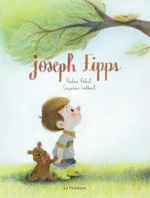 Because of his curious and sometimes impulsive nature, Joseph Fipps simply can't stay out of trouble. After his mother reprimands him one too many times, he decides it is his mother, not he, who needs to change. As he sulks in the yard, Joseph imagines what it might be like to have a different mother. While his imagination takes him on an interesting journey, he also comes to realize that his mother provides steadfast support and affection. Lovely, softly-hued illustrations accompany this story about independence, imagination, love, and conflict. The last two heart-warming images will reassure readers that love transcends even those tough times when parent and child seem to be at cross purposes.
Because of his curious and sometimes impulsive nature, Joseph Fipps simply can't stay out of trouble. After his mother reprimands him one too many times, he decides it is his mother, not he, who needs to change. As he sulks in the yard, Joseph imagines what it might be like to have a different mother. While his imagination takes him on an interesting journey, he also comes to realize that his mother provides steadfast support and affection. Lovely, softly-hued illustrations accompany this story about independence, imagination, love, and conflict. The last two heart-warming images will reassure readers that love transcends even those tough times when parent and child seem to be at cross purposes.
—Barbara A. Ward, Washington State University Pullman
Grades 4-6
Becker, Suzy. (2014). Kate the Great, Except When She’s Not. New York, NY: Random House/Crown Books for Young Readers.
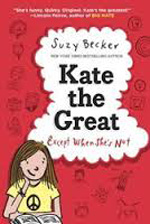 Despite being stuck in the middle in her family, fifth grader Kate Geller enjoys her life. When the father of one of her classmates has to be away from home for an extended period, Kate's mother insists she befriend the girl. But Nora is not easy to handle, and she seems uninterested in being befriended and resists Kate’s overtures. Just as she finally starts warming up to Kate, their friendship has a set-back, and Nora refuses to talk to Kate. Filled with doodles in a style similar to the Diary of a Wimpy Kid series, the book features a protagonist who is refreshingly nice to just about everyone but who also disagrees (politely) with her art teacher and other adults. There are several sub-plots to keep readers engaged as conflicts between various girls escalate. Things are resolved fairly easily despite several missteps by Kate. Readers may decide that their favorite parts of the book concern Kate's ongoing battle with her art teacher, Mrs. Petty, who insists Kate conform to her own preconceived notions about art, something Kate simply cannot bring herself to do.
Despite being stuck in the middle in her family, fifth grader Kate Geller enjoys her life. When the father of one of her classmates has to be away from home for an extended period, Kate's mother insists she befriend the girl. But Nora is not easy to handle, and she seems uninterested in being befriended and resists Kate’s overtures. Just as she finally starts warming up to Kate, their friendship has a set-back, and Nora refuses to talk to Kate. Filled with doodles in a style similar to the Diary of a Wimpy Kid series, the book features a protagonist who is refreshingly nice to just about everyone but who also disagrees (politely) with her art teacher and other adults. There are several sub-plots to keep readers engaged as conflicts between various girls escalate. Things are resolved fairly easily despite several missteps by Kate. Readers may decide that their favorite parts of the book concern Kate's ongoing battle with her art teacher, Mrs. Petty, who insists Kate conform to her own preconceived notions about art, something Kate simply cannot bring herself to do.
—Barbara A. Ward, Washington State University Pullman
Ellis, Deborah. The Cat at the Wall. Toronto: Groundwood Books/House of Anansi Press.
 A stray cat slips into a tiny house in Palestine as two Israeli soldiers decide to use it as a base for surveillance. It turns out the house is not as empty as the soldiers had thought it was, and the soldiers don’t know what to do with the boy hiding there. One event leads to another, and before they know it, the men are surrounded by protesters intent on driving them from the house. As the tension rises and Israeli tanks and planes can be heard approaching the area, it’s clear things won’t turn out well. After all, there is too much bad history on both sides for the conflict to be resolved peacefully. In a twist, it’s revealed that the cat was once a 13-year-old girl named Clare who fought (and lost) a yearlong battle with the teacher she called Ms. Zero. Clare realizes the battle was rather pointless, and she has misunderstood many of the events of that turbulent school year. She races between the two sides, begins to dance, and dispels the tension so both sides can go their own ways. “Maybe the world is not completely rotten,” she reflects. There is much to consider about the issues and history that divide us as well as those commonalities.
A stray cat slips into a tiny house in Palestine as two Israeli soldiers decide to use it as a base for surveillance. It turns out the house is not as empty as the soldiers had thought it was, and the soldiers don’t know what to do with the boy hiding there. One event leads to another, and before they know it, the men are surrounded by protesters intent on driving them from the house. As the tension rises and Israeli tanks and planes can be heard approaching the area, it’s clear things won’t turn out well. After all, there is too much bad history on both sides for the conflict to be resolved peacefully. In a twist, it’s revealed that the cat was once a 13-year-old girl named Clare who fought (and lost) a yearlong battle with the teacher she called Ms. Zero. Clare realizes the battle was rather pointless, and she has misunderstood many of the events of that turbulent school year. She races between the two sides, begins to dance, and dispels the tension so both sides can go their own ways. “Maybe the world is not completely rotten,” she reflects. There is much to consider about the issues and history that divide us as well as those commonalities.
—Barbara A. Ward, Washington State University Pullman
Giff, Patricia Reilly. (2014). Hunter Moran Digs Deep. Illus. by Chris Sheban. New York, NY: Holiday House.
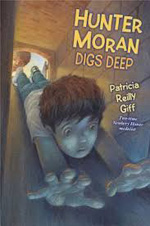 With each new entry in this series, readers will grow increasingly enchanted by the highly-entertaining Moran family. In this installment, Hunter and his twin brother Zack become convinced that one of their ancestors hid treasure somewhere nearby. The two boys unwillingly team up with the annoying Sarah Yulefsky who has her eyes set on Hunter and on finding the treasure. But others are following the same clues as they have, and it's a race to see who will find the treasure first. As they dig up ground, slide down chutes, and try to fool a couple of nuns, the youngsters scare up plenty of fun and a fright or two. In the end Hunter just may have found his true talent. Mom's inability to prepare an edible meal or dish—even her cookies are slightly burned at the edges—and Father's preoccupation with his job and cluelessness about what his boys are up to only add to the complexity of the book and the series. Simply brimming with examples of the ties that bind families, this book is, above all, fun to read and highly entertaining.
With each new entry in this series, readers will grow increasingly enchanted by the highly-entertaining Moran family. In this installment, Hunter and his twin brother Zack become convinced that one of their ancestors hid treasure somewhere nearby. The two boys unwillingly team up with the annoying Sarah Yulefsky who has her eyes set on Hunter and on finding the treasure. But others are following the same clues as they have, and it's a race to see who will find the treasure first. As they dig up ground, slide down chutes, and try to fool a couple of nuns, the youngsters scare up plenty of fun and a fright or two. In the end Hunter just may have found his true talent. Mom's inability to prepare an edible meal or dish—even her cookies are slightly burned at the edges—and Father's preoccupation with his job and cluelessness about what his boys are up to only add to the complexity of the book and the series. Simply brimming with examples of the ties that bind families, this book is, above all, fun to read and highly entertaining.
—Barbara A. Ward, Washington State University Pullman
Spinelli, Eileen. (2014). Another Day as Emily. Illus. by Joanne Lew-Vriethoff. New York, NY: Knopf Books for Young Readers.
 It’s not as though tween Suzy Quinn doesn’t love her little brother Parker or wants to fight with him. But when his act of heroism causes him to achieve a small measure of fame in their small town, enough is enough. Suzy becomes more than a little disconcerted by all the attention showered on Parker when he saves a neighbor's life. It's not that she's jealous of him—oh, maybe a little bit—but surely she deserves some notice too. To add insult to injury, Suzy doesn't make the cut for a local play and her birthday road trip is spoiled too. Since her book discussion group is focusing on the 1800s, Suzy decides to emulate poet Emily Dickinson and withdraw from society. Not only does she start wearing white, writing very bad poetry, and refusing to communicate via the telephone, but she changes her name and her goldfish's name. But Suzy is gregarious by nature and definitely not reclusive. While Suzy's behavior is certainly over the top by anyone's standards, this novel in verse aptly depicts a girl trying to find her place in the world, even if the world is only as large as her family and community. The conflict between Suzy’s current identity and whom she wants to be is quite obvious.
It’s not as though tween Suzy Quinn doesn’t love her little brother Parker or wants to fight with him. But when his act of heroism causes him to achieve a small measure of fame in their small town, enough is enough. Suzy becomes more than a little disconcerted by all the attention showered on Parker when he saves a neighbor's life. It's not that she's jealous of him—oh, maybe a little bit—but surely she deserves some notice too. To add insult to injury, Suzy doesn't make the cut for a local play and her birthday road trip is spoiled too. Since her book discussion group is focusing on the 1800s, Suzy decides to emulate poet Emily Dickinson and withdraw from society. Not only does she start wearing white, writing very bad poetry, and refusing to communicate via the telephone, but she changes her name and her goldfish's name. But Suzy is gregarious by nature and definitely not reclusive. While Suzy's behavior is certainly over the top by anyone's standards, this novel in verse aptly depicts a girl trying to find her place in the world, even if the world is only as large as her family and community. The conflict between Suzy’s current identity and whom she wants to be is quite obvious.
—Barbara A. Ward, Washington State University Pullman
Grades 7-8
Higgins, Nadia. (2014). The Split History of the Civil Rights Movement: Activists’ Perspective/Segregationists’ Perspective. Mankato, MN: Capstone/Compass Point Books.
 Another entry in the excellent Split History series providing two opposing perspectives on important issues, this book examines the Civil Rights Movement through text and photographs. Readers are able to understand the conflict by reading separately the point of view of segregationists and politicians who took advantage of the fears of local voters and then the point of view of those who wanted to make change through voter registration drives and education. Although the accounts of the important protests, walks, and boycotts are brief, readers can use the text and photographs to get a sense of the place and time and ponder the events that lead to social change as well as the resistance that tries to counter that change.
Another entry in the excellent Split History series providing two opposing perspectives on important issues, this book examines the Civil Rights Movement through text and photographs. Readers are able to understand the conflict by reading separately the point of view of segregationists and politicians who took advantage of the fears of local voters and then the point of view of those who wanted to make change through voter registration drives and education. Although the accounts of the important protests, walks, and boycotts are brief, readers can use the text and photographs to get a sense of the place and time and ponder the events that lead to social change as well as the resistance that tries to counter that change.
—Barbara A. Ward, Washington State University Pullman
Petruck, Rebecca. (2014). Steering Toward Normal. New York, NY: Harry N. Abrams.
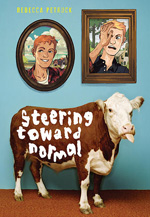 Eighth grader Diggy Lawson has his eyes on the big prize at the state fair this year and, as a result, capturing the attention of the older girl on whom he has a crush. Things start off well since Joker, his steer, is easy to train. But when the family dynamics change with the addition of Wayne, a half-brother he didn’t know existed, Diggy begins questioning things a lot of things. While he has some empathy for Wayne who is grieving after the loss of his mother from cancer, Diggy worries he is losing his father to Wayne. He also becomes angry about never having known his own mother. The book is filled with humor and characters that behave and speak like real human beings even while the brothers work out their conflicts in different ways. While Diggy's confusion is understandable, he does the best he can under stressful conditions. Just as the boys realize that raising the steers means leading them to be slaughtered after the fair ends, the adults in the story also come to some realizations about what matters in a family.
Eighth grader Diggy Lawson has his eyes on the big prize at the state fair this year and, as a result, capturing the attention of the older girl on whom he has a crush. Things start off well since Joker, his steer, is easy to train. But when the family dynamics change with the addition of Wayne, a half-brother he didn’t know existed, Diggy begins questioning things a lot of things. While he has some empathy for Wayne who is grieving after the loss of his mother from cancer, Diggy worries he is losing his father to Wayne. He also becomes angry about never having known his own mother. The book is filled with humor and characters that behave and speak like real human beings even while the brothers work out their conflicts in different ways. While Diggy's confusion is understandable, he does the best he can under stressful conditions. Just as the boys realize that raising the steers means leading them to be slaughtered after the fair ends, the adults in the story also come to some realizations about what matters in a family.
—Barbara A. Ward, Washington State University Pullman
Grades 9-12
Hubbard, Jenny. (2014). And We Stay. New York NY: Random House/Delacorte.
 Budding poet Emily Bean has left her hometown for boarding school in the wake of a tragedy and feels conflicted about her role in that tragedy. The story covers the three months after Paul Wagoner, Emily's boyfriend, killed himself in the school library. In the aftermath, Emily's family decides she should begin the healing process at a boarding school in Amherst, MA. It's clear from the opening pages that Emily is haunted by what happened and desperate to keep everything that happened back home a secret. Perhaps because of the school's location near Dickinson's home, or as writing therapy, or even possibly because the famous poet's spirit is helping her, Emily begins to write poetry. With every line, readers are able to count the costs of the decisions she made during the last part of the previous year when she turned 17. Filled with raw pain and budding awareness and sorrow, the poems are exquisitely wrought and memorable. Despite her regrets, she realizes what we all must eventually come to terms with: Regrets don't change anything and they certainly don't bring anyone back to life. It takes great courage to stay and live life, despite its challenges, when so many others are choosing to leave.
Budding poet Emily Bean has left her hometown for boarding school in the wake of a tragedy and feels conflicted about her role in that tragedy. The story covers the three months after Paul Wagoner, Emily's boyfriend, killed himself in the school library. In the aftermath, Emily's family decides she should begin the healing process at a boarding school in Amherst, MA. It's clear from the opening pages that Emily is haunted by what happened and desperate to keep everything that happened back home a secret. Perhaps because of the school's location near Dickinson's home, or as writing therapy, or even possibly because the famous poet's spirit is helping her, Emily begins to write poetry. With every line, readers are able to count the costs of the decisions she made during the last part of the previous year when she turned 17. Filled with raw pain and budding awareness and sorrow, the poems are exquisitely wrought and memorable. Despite her regrets, she realizes what we all must eventually come to terms with: Regrets don't change anything and they certainly don't bring anyone back to life. It takes great courage to stay and live life, despite its challenges, when so many others are choosing to leave.
—Barbara A. Ward, Washington State University Pullman
Novgorodoff, Danica. (2014). The Undertaking of Lily Chen. New York, NY: Macmillan/First Second.
 This magnificent graphic novel set in China brings to light a centuries-old practice of finding a bride to accompany an unmarried man in the afterlife. When Deshi Li causes his brother's death, his parents persuade him that it is his duty to insure that his brother has a ghost wife. He sets off on a journey that leads him to an unsavory connections, and along the way, he encounters Lily, desperate to thwart her father’s plans to marry her off to a local man. Deshi intends to sacrifice Lily for his older brother, but filial duty conflicts with budding love for her, and he simply cannot bring himself to kill her. Readers will be swept into this unusual story with its violence, sadness, and humor mingled with a glimmer of hope for the two lost souls at its center. Could it be that love could save them both? The illustrations are lush and evoke a sense of the immense, beautiful, and isolated rural landscape where the story plays out. Although the story's focus is microscopic, involving only a handful of individuals, its impact is enormous, forcing readers to think about the ways of love and familial expectations. This must-read graphic novel is worth savoring and rereading.
This magnificent graphic novel set in China brings to light a centuries-old practice of finding a bride to accompany an unmarried man in the afterlife. When Deshi Li causes his brother's death, his parents persuade him that it is his duty to insure that his brother has a ghost wife. He sets off on a journey that leads him to an unsavory connections, and along the way, he encounters Lily, desperate to thwart her father’s plans to marry her off to a local man. Deshi intends to sacrifice Lily for his older brother, but filial duty conflicts with budding love for her, and he simply cannot bring himself to kill her. Readers will be swept into this unusual story with its violence, sadness, and humor mingled with a glimmer of hope for the two lost souls at its center. Could it be that love could save them both? The illustrations are lush and evoke a sense of the immense, beautiful, and isolated rural landscape where the story plays out. Although the story's focus is microscopic, involving only a handful of individuals, its impact is enormous, forcing readers to think about the ways of love and familial expectations. This must-read graphic novel is worth savoring and rereading.
—Barbara A. Ward, Washington State University Pullman
These reviews and resources are submitted by members of the International Reading Association’s Children’s Literature and Special Interest Group (CL/R SIG) and are published weekly on Reading Today Online.